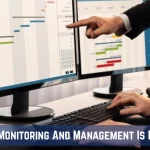Are you struggling to navigate the complexity of assessing your team’s productivity and contributions? In the maze of modern workplaces, understanding and optimizing employee performance is a challenge many employers face.
Looking for a solution? Effective performance tracking is what you need. But what exactly does this entail, and how can it bring relief to your management woes?
In this blog, we will shed light on its incredible benefits and explore crucial ways that can revolutionize how you evaluate your team’s performance. Beyond mere numbers, this is about crafting a culture of excellence. Learn the strategies to efficiently track employee performance, from setting realistic goals and empowering self-monitoring to fostering continual learning and establishing robust feedback channels.
However, there are some pitfalls you have to keep in mind, like micromanagement, demoralizing metrics, etc. You can elevate your efforts with advanced employee monitoring software, seamlessly integrating these strategies into your workflow. Get ready to transform your workplace with savvy performance tracking. This blog is your pathway to maximizing your team’s potential!
Hit ‘Play’ Button & Tune Into The Blog!
What Is Employee Performance Tracking And Its Benefits?
Tracking employee performance involves evaluating and managing employees’ work activities and achievements within an organization. It encompasses measuring their productivity, quality of work, adherence to goals, and overall contribution to the company’s objectives.
A employee performance tracking system aligned with your company’s objectives and culture offers numerous meaningful benefits to your organization. This system, when tailored effectively, brings forth several advantages in the workplace,
Enhances employee performance and efficiency: By tracking performance, you can identify areas for improvement, offer necessary support, and create strategies to boost efficiency.
Identifies strengths and weaknesses: This helps recognize where each employee excels and where they might need additional training or support.
Fosters innovation through feedback and improvement: A performance tracking system that encourages feedback cultivates an environment where employees feel empowered to suggest improvements and innovate.
Assesses individual skills to assign the most suitable roles: Understanding each employee’s skill set enables better role allocation, ensuring tasks align with their strengths.
Improves overall workplace productivity: When employees are in roles that match their skills and receive necessary support, it positively impacts overall productivity.
Raises employee morale by recognizing achievements: Acknowledging good performance boosts morale and motivates employees to continue excelling.
Fosters a strong sense of accountability and responsibility: Employees become more accountable for their tasks and performance, promoting a responsible work culture.
Increases agility and flexibility: Through performance tracking, organizations can adapt swiftly by identifying areas that require adjustments or changes. It fosters a culture of adaptability, allowing the organization to respond promptly to market shifts or evolving business needs.
How To Perform Employee Performance Tracking Effectively?
1. Establishing Realistic Goals
Establishing clear expectations for employees regarding their roles and responsibilities is crucial for optimal performance. However, it’s essential to ensure that they truly grasp what’s expected of them and what’s required. If this becomes a hurdle in their efficiency, it might signal a need to reassess your approach to goal-setting.
A beneficial strategy involves setting achievable performance goals and objectives for your employees in the long run. Avoid overwhelming them with tasks; instead, consider employing OKRs (Objectives and Key Results) and implementing KPIs (Key Performance Indicators) to monitor individual accomplishments. This approach aids in identifying strengths and weaknesses, enabling tailored training programs to enhance skills and contribute to the organization’s success. You can also use business goals templates to define, plan, and set your work goals and aspirations.
2. Promote Smart Work
In every organization, there are diligent and dedicated employees. However, in today’s modern corporate landscape, relying solely on hard work is insufficient to meet expectations.
Instead, employees should emphasize maintaining a well-balanced approach between hard work and smart work, adhering to the SMART goal framework. By setting Specific, Measurable, Achievable, Relevant, and Time-bound objectives, they can excel in their roles and responsibilities.
Encourage employees to embrace the SMART goal plan, fostering efficiency and encouraging innovative thinking. This approach enhances creativity in the workplace. Additionally, managers can leverage an employee performance tracking system to monitor individual growth.
This system provides accurate performance metrics, facilitating adaptation to ongoing changes. This adaptability is crucial for improving employee performance and achieving greater organizational success.
3. Review Progress Regularly
It’s crucial to highlight that organizations should employ micromanagement techniques for monitoring productivity as it erodes the trust between employers and employees. Instead, team members should view performance tracking, including employee self-evaluation, as a means of staying ahead of bottlenecks, and managers should view it as a means of facilitating learning and development.
Apart from performance reviews and informal one-on-ones, leverage feedback tools, communication channels, and employee monitoring software like EmpMonitor. These tools can help discuss which goals are progressing and which are stuck. Managers can ask team members questions like:
- Are there any adjustments or changes you need to make to your approach to stay on track?
- Do you need any additional support or resources to achieve your goals?
- Have you reached any significant milestones or accomplished specific subgoals?
4. Create A Robust Feedback Channel And Conduct Surveys
An essential part of an employee performance tracking system is understanding employees’ viewpoints regarding their roles and performance. It starts with asking precise survey questions that delve into their responsibilities and performance standards.
Surveys yield critical insights into employee satisfaction and their developmental trajectory. Identifying hurdles allows for targeted solutions, fostering elevated performance levels and cultivating a productive, engaged workforce.
Constructive, timely, detailed, and honest employee feedback is fundamental for organizations dedicated to enhancing business performance and development. Clarity in communication ensures a clear understanding of conveyed messages, minimizing confusion.
5. Prioritize Continuous Learning
Developing new skills is crucial for personal and professional growth. Yet, without a genuine enthusiasm for learning, adapting to changes can become challenging, impeding progress in both personal and professional spheres.
This principle holds true in the workplace, where employees need to embrace a learning-oriented mindset to navigate evolving environments effectively. Continuously revisiting and honing acquired skills ensures an ongoing learning journey, crucial in today’s digitally advancing corporate landscape, characterized by substantial changes in tactics and workflows.
Promoting a culture of continuous learning is crucial in understanding and navigating transitions, especially when integrated with performance tracking. This approach not only equips employees to remain technologically proficient but further encourages a mindset of adaptability and improvement for long-term success.
6. Encourage Self-Monitoring With Tracking Tools
Empower your employees by promoting self-monitoring through utilizing employee performance tracker tools. By encouraging the use of these tools, individuals gain autonomy in overseeing their progress and performance. These resources enable them to take charge of their professional development, fostering a sense of ownership and accountability in meeting their goals.
This approach enhances individual growth and cultivates a proactive mindset within the workforce. Employers can use tools like EmpMonitor, which will provide employees with a report of their performance and productivity.
7. Evaluate Progress During One-On-One Meetings
Some companies have shifted away from semi-annual formal performance reviews, opting for more frequent weekly or bi-weekly 1:1 check-ins. Others retain traditional assessments while integrating additional informal meetings into their structure.
Regardless of the chosen approach, regular virtual or in-person meetings remain pivotal for managers and their teams to gauge progress toward goals. These meetings serve as a platform to address deviations and devise strategies and solutions collaboratively. Consider these guiding principles for effective meetings:
- Initiate each meeting by reviewing progress to pinpoint milestones and identify obstacles.
- Promote collaboration in meetings, encouraging team members to contribute ideas.
- Assign action items to employees, specifying tasks to address before the next meeting for clear objectives.
- Avoid expecting a 100% success rate for goals; a 70% or 80% achievement is often indicative of significant progress in most frameworks.
Bonus Tip
One valuable tip is to avoid expecting employees to reach 100% of their goals. The pressure this expectation creates outweighs the potential benefits. Striving for absolute perfection doesn’t enhance performance; instead, it can immobilize employees, hindering their willingness to take risks and innovate, which is counterproductive. Embracing human fallibility acknowledges that growth often stems from learning through errors.
Optimize Performance Tracking With EmpMonitor
Enhance your performance tracking system by integrating EmpMonitor, a comprehensive employee monitoring software suite. EmpMonitor streamlines performance management by offering a diverse range of tools. It tracks productivity, monitors tasks, and analyzes work patterns, providing insightful reports within a centralized platform for efficient management.
It enables data-driven decision-making, fosters employee engagement, identifies strengths, and addresses weaknesses, significantly boosting effectiveness in performance management. Additionally, EmpMonitor includes advanced functionalities like keystroke logging, application and website monitoring, time tracking, and comprehensive activity analysis.
Leveraging these capabilities promotes accountability, facilitates better time management, and refines workflows for heightened productivity. By integrating EmpMonitor, organizations transform their management approaches, ensuring a streamlined and secure work environment while minimizing data risks.
Learn More
What Is Performance Management Software? 5 Tips To Enhance Performance Management Systems
Top 12 Benefits Of Employee Monitoring Software
04 Smart Strategy To Achieve Performance Goals
Top 8 Business Performance Strategies For Your Business
Performance Tracking Pitfalls to Avoid
Avoiding pitfalls in tracking performance is crucial for fostering a positive work environment and maximizing productivity. By steering clear of these common mistakes, organizations can ensure that their performance tracking systems contribute positively to employee engagement and growth. These pitfalls include:
Over-Monitoring: Excessive monitoring, scrutinizing every aspect of employee activity, can foster mistrust and harm relationships, detracting from a healthy work atmosphere.
Negative Feedback Approach: Linking performance feedback solely to tracking can create a punitive environment. Constructive criticism should focus on improvement and maintaining a positive and encouraging tone.
Numerical Ratings: Using numerical scales can demoralize employees. Instead, offering qualitative feedback that emphasizes meeting or exceeding expectations fosters a more motivating atmosphere.
Uniform Rewards for Achievements: Failing to differentiate between minor and major achievements can reduce the incentive for significant wins. Celebrating big victories uniquely can drive motivation and enthusiasm.
Lack of Transparency: Withholding performance data from employees can hamper their ability to adapt and improve. Granting access to their progress encourages self-motivation and proactive adjustments.
Final Words
Utilizing performance tracking in the workplace is crucial for assessing and understanding your team’s performance. But it’s more than just ticking boxes or monitoring every move they make. It’s about nurturing their growth and enabling them to excel. This blog explored effective strategies to achieve this without causing stress or making everyone feel overly scrutinized.
Setting attainable goals and supporting your team as they accomplish them is vital. Rather than relying on scores, emphasizing ongoing improvement and assistance contributes to a more positive atmosphere. Additionally, acknowledging significant achievements can have a profound impact.
Performance management software like EmpMonitor aids in monitoring activities, but fostering trust within your team and providing them with the necessary information is equally crucial for optimal performance. It goes beyond mere metrics; it involves cultivating a positive team environment where everyone feels empowered and aligned with their goals. Consistent support for your team cultivates an environment where every individual thrives, contributing to a shared narrative of success in the workplace.









